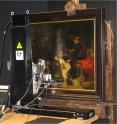Science shows there is more to a Rembrandt than meets the eye
Art historians and scientists use imaging methods to virtually "dig" under or scan various layers of paint and pencil. This is how they decipher how a painter went about producing a masterpiece -- without harming the original. A comparative study with a Rembrandt van Rijn painting as its subject found that the combined use of three imaging techniques provides valuable complementary information about what lies behind this artwork's complex step-by-step creation. The study, led by Matthias Alfeld of the University of Antwerp in Belgium, is published in Springer's journal Applied Physics A: Materials Science and Processing. Rembrandt's oil painting Susanna and the Elders is dated and signed 1647. It hangs in the art museum Gemäldegalerie in Berlin, Germany. The painting contains a considerable amount of the artist's changes or so-called pentimenti (from the Italian verb pentire: ''to repent") underneath the current composition. This was revealed in the 1930s when the first X-ray radiography (XRR) was done on it. More hidden details about changes made with pigments other than lead white were discovered when the painting was investigated in 1994 using neutron activation autoradiography (NAAR).
Alfeld's team chose to investigate Susana and the Elders not only because of its clearly visible pentimenti, but also because of its smaller size. Macro-X-ray fluorescence (MA-XRF) scans could thus be done in a single day using an in-house scanner at the museum in Berlin. These were then compared to existing radiographic images of the painting.
All three techniques (the early X-ray radiography, and the later neutron activation autoradiography and the recently developed macro-X-ray fluorescence scans) reveal considerable changes were made to the painting. Alfeld's team found that the images of the elements used which were acquired by X-ray fluorescence scans are the easiest to interpret. This is because most of the individual elements are clearly separated. A broader range of elements can also be studied, compared to using autoradiography. However, X-ray fluorescence scans can only be used to detect bone black on the surface of a painting and not in sub-surface layers, such as is found in hidden sketches.
Autoradiography is a very suitable tool to study pigments such as bone black, umber, copper-based greens and blues, smalt and vermilion, but not for calcium, iron and lead. It is also the only method capable of visualizing phosphorus, present in bone black, in lower paint layers. With X-ray radiography and autoradiography, single brush strokes can be discerned, which helps with the study of the painting technique employed.
"Given the relatively short time and less effort required for investigations using X-ray fluorescence scans, this technique is expected to be applied more frequently in the future than autoradiography," says Alfeld. "However, due to the capability of the latter method to visualize the distribution of certain elements through strongly absorbing covering layers, both methods ultimately provide complementary information. This is especially true for phosphorus, which was found present in the sketching of the painting investigated."
Source: Springer Science+Business Media
Other sources
- X-Ray Scans 'Dig' Beneath Layers of Rembrandt Paintingfrom Live ScienceWed, 15 Apr 2015, 18:00:12 UTC
- Science shows there is more to a Rembrandt than meets the eyefrom Science BlogTue, 14 Apr 2015, 16:00:16 UTC
- There is more to a Rembrandt than meets the eye, science showsfrom Science DailyTue, 14 Apr 2015, 14:31:22 UTC
- Science shows there is more to a Rembrandt than meets the eyefrom PhysorgTue, 14 Apr 2015, 13:30:10 UTC
